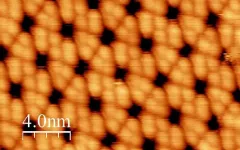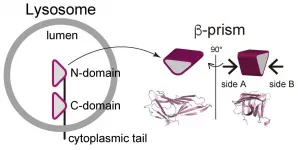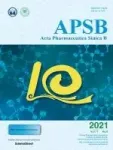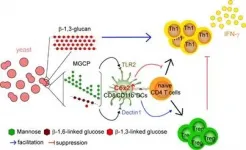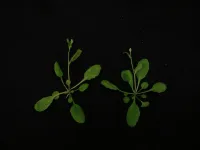(Press-News.org) To make computer chips, technologists around the world rely on atomic layer deposition (ALD), which can create films as fine as one atom thick. Businesses commonly use ALD to make semiconductor devices, but it also has applications in solar cells, lithium batteries and other energy-related fields.
Today, manufacturers increasingly rely on ALD to make new types of films, but figuring out how to tweak the process for each new material takes time.
Part of the problem is that researchers primarily use trial and error to identify optimal growth conditions. But a recently published study -- one of the first in this scientific field -- suggests that using artificial intelligence (AI) can be more efficient.
In the ACS Applied Materials & Interfaces study, researchers at the U.S. Department of Energy's (DOE) Argonne National Laboratory describe multiple AI-based approaches for optimizing the ALD processes autonomously. Their work details the relative strengths and weaknesses of each approach, as well as insights that can be used to develop new processes more efficiently and economically.
"All of these algorithms provide a much faster way of converging to optimum combinations because you're not spending time putting a sample in the reactor, taking it out, doing measurements etc. as you typically would today. Instead you have a real-time loop that connects with the reactor," said Argonne principal materials scientist Angel Yanguas-Gil, a co-author of the study.
Cutting edge, but with challenges
In ALD, two different chemical vapours, known as precursors, adhere to a surface, adding a thin layer of film in the process. This all happens inside a chemical reactor and is sequential: one precursor is added and interacts with the surface, then any excess of it is removed. Afterwards the second precursor is introduced then later removed, and the process repeats itself. In microelectronics, the ALD thin film might be used to electrically insulate nearby components in nanoscale transistors.
ALD excels at growing precise, nanoscale films on complex, 3D surfaces such as the deep and narrow trenches patterned into silicon wafers to manufacture today's computer chips. This has motivated scientists worldwide to develop new thin film ALD materials for future generations of semiconductor devices.
However, developing and optimizing these new ALD processes is challenging and labor-intensive. Researchers have to consider many different factors that can alter the process, including:
The complex chemistries between the molecular precursors
Reactor design, temperature and pressure
The timing for each dose of their precursors
In an effort to find ways of overcoming these challenges, Argonne scientists evaluated three optimization strategies -- random, expert system and Bayesian optimization -- the latter two utilizing different AI approaches.
Set it and forget it
Researchers evaluated their three strategies by comparing how they optimized the dosage and purge times of the two precursors used in ALD. Dosage time refers to the time period when a precursor is added to the reactor, while purge time refers to the time needed to remove excess precursor and gaseous chemical products.
The goal: Find the conditions that would achieve high and stable film growth in the shortest time. Scientists also judged the strategies on how quickly they converged on the ideal set of timings using simulations that represented the ALD process inside a reactor.
Linking their optimization approaches to their simulated system let them measure film growth in real time after each cycle, based on the processing conditions their optimization algorithms generated.
"All of these algorithms provide a much faster way of converging to optimum combinations because you're not spending time putting a sample in the reactor, taking it out, doing measurements, etc., as you would, typically. Instead you have a real-time loop that connects with the reactor," said Argonne Principal Materials Scientist Angel Yanguas-Gil, a co-author of the study.
This set up also made the process automatic for the two AI approaches by forming a closed-loop system.
"In a closed-loop system, the simulation performs an experiment, gets the results, and feeds it to the AI tool. The AI tool then learns from it or interprets it in some way, and then suggests the next experiment. And this all happens without human input," said Noah Paulson, a computational scientist at Argonne and the lead author.
Despite some weaknesses, the AI approaches effectively determined the optimal dose and purge timings for different simulated ALD processes. This makes the study among the first to show that thin-film optimization in real time is possible using AI.
"This is exciting because it opens up the possibility of using these types of approaches to rapidly optimize real ALD processes, a step that could potentially save manufacturers precious time and money when developing new applications in the future," concluded Jeff Elam, a senior chemist at Argonne and co-author.
INFORMATION:
For partnership opportunities, contact partners@anl.gov
The scientists used Argonne's Blues cluster in its Laboratory Computing Resource Center. This research was funded by the Laboratory Directed Research and Development (LDRD) program at Argonne.
Argonne National Laboratory seeks solutions to pressing national problems in science and technology. The nation's first national laboratory, Argonne conducts leading-edge basic and applied scientific research in virtually every scientific discipline. Argonne researchers work closely with researchers from hundreds of companies, universities, and federal, state and municipal agencies to help them solve their specific problems, advance America's scientific leadership and prepare the nation for a better future. With employees from more than 60 nations, Argonne is managed by UChicago Argonne, LLC for the U.S. Department of Energy's Office of Science.
The U.S. Department of Energy's Office of Science is the single largest supporter of basic research in the physical sciences in the United States and is working to address some of the most pressing challenges of our time. For more information, visit https://energy.gov/science.
ALBUQUERQUE, N.M. -- Like two superheroes finally joining forces, Sandia National Laboratories' Z machine -- generator of the world's most powerful electrical pulses -- and Lawrence Livermore National Laboratory's National Ignition Facility -- the planet's most energetic laser source -- in a series of 10 experiments have detailed the responses of gold and platinum at pressures so extreme that their atomic structures momentarily distorted like images in a fun-house mirror.
Similar high-pressure changes induced in other settings have produced oddities like hydrogen appearing as a metallic fluid, helium in the form of rain and sodium a transparent metal. But until now there has been no way to accurately calibrate these pressures and responses, the first step to ...
Tsukuba, Japan - Organic light-emitting diodes (OLEDs) are widely used in display technology and are also being investigated for lighting applications. A comprehensive understanding of these devices is therefore important if their properties are to be harnessed to their full potential. Researchers from the University of Tsukuba have directly observed the photoexcited electron dynamics in an organic film using time-resolved photoelectron emission microscopy. Their findings are published in Advanced Optical Materials .
OLED displays are popular because they are bright, lightweight, and do not consume a lot of power. Their output is generated when an exciton--a combination of an electron and an electron hole--releases its energy. However, this ...
Tokyo, Japan - A cell is composed of numerous organelles, each with a unique role that helps contribute to its overall functionality. The lysosome is an organelle that contains digestive enzymes and functions as a molecular garbage disposal and recycling center. Since the role of lysosome is crucial to maintain the cellular homeostasis, the lysosomal dysfunction causes neurodegenerative and metabolic diseases, cancer, as well as lysosomal storage disorders.
In a new article published in Autophagy, researchers at Tokyo Medical and Dental University (TMDU) performed a novel type of structural analysis to demonstrate how a certain molecular interaction is crucial for one lysosomal membrane protein to perform effectively.
LAMP1 (lysosomal-associated ...
LA JOLLA, CA--Chemists at Scripps Research have solved a long-standing problem in their field by developing a method for making a highly useful and previously very challenging type of modification to organic molecules. The breakthrough eases the process of modifying a variety of existing molecules for valuable applications such as improving the potency and duration of drugs.
The flexible new method, for "directed C--H hydroxylation with molecular oxygen," does what only natural enzymes have been able to do until now. It's described in a paper this week in Science.
"We ...
James Cook University scientists in Australia believe they have made a breakthrough in the science of keeping premature babies alive.
As part of her PhD work, JCU engineering lecturer Stephanie Baker led a pilot study that used a hybrid neural network to accurately predict how much risk individual premature babies face.
She said complications resulting from premature birth are the leading cause of death in children under five and over 50 per cent of neonatal deaths occur in preterm infants.
"Preterm birth rates are increasing almost everywhere. In neonatal intensive care units, assessment of mortality risk assists in making difficult decisions regarding which treatments should be used and if and when treatments are working effectively," said Ms Baker. ...
RICHLAND, Wash.--Earth bears many signs of human influence, from warming that exceeds pre-industrial temperatures to a rising sea. Add to that list, now, the human influence on the timing of Earth's water cycle, revealed by a new study led by researchers at the U.S. Department of Energy's Pacific Northwest National Laboratory.
The research, published this week in the journal Nature Climate Change, peels back layers of climatological noise to uncover a clear signal: from 1979 to 2019, increases in greenhouse gases and reductions in human-generated aerosols triggered an approximate four-day delay in seasonal rainfall over tropical land and the Sahel. The lag could mean delayed crop production, ...
We can generally recognize an object, even if it is presented for a very brief time. However, if another object appears immediately following the first object, the perception on the first object is impaired such that we do not notice its existence. This perceptual phenomenon, called "visual backward masking," is used in vision science to study how visual perception is processed in the brain. Interestingly, this phenomenon occurs even if the second object does not spatially overlap the first object, such as a contour or four dots surrounding the object.
The occurrence of this phenomenon is assumed to be due to a disruption of "feedback processing." When we see something, visual ...
In 2021 Acta Pharmaceutica Sinica B (APSB) is celebrating its 10th anniversary. The journal was founded with the goal of creating a global high-level forum centred around drug discovery and pharmaceutical research/application. APSB was included by Chemical Abstracts in 2011, accepted by PubMed Central in 2015, indexed by Science Citation Index in 2017 and has evolved to become one of the most important international journals in the field of pharmaceutical sciences.
Volume 11, issue 6 is a special issue marking the beginning of a series of celebratory events ...
The development of therapeutic drugs for inflammatory bowel disease, an intractable immune disease, and multiple sclerosis - an autoimmune disorder - is gaining traction. A research team from the Department of Life Sciences at POSTECH and a joint research team at ImmunoBiome Inc. have uncovered that a yeast-derived polysaccharide mixture inhibits the onset and progression of immune disorders.
The number of cases of Crohn's disease and ulcerative colitis - both inflammatory bowel diseases - in Korea was about 18,000 and 37,000 respectively as of 2019, increasing about 2.3 times ...
With a goal of breeding resilient crops that are better able to withstand drought and disease, University of California San Diego scientists have developed the first CRISPR-Cas9-based gene drive in plants.
While gene drive technology has been developed in insects to help stop the spread of vector-borne diseases such as malaria, researchers in Professor Yunde Zhao's lab, along with colleagues at the Salk Institute for Biological Studies, demonstrated the successful design of a CRISPR-Cas9-based gene drive that cuts and copies genetic elements in Arabidopsis plants.
Breaking ...

